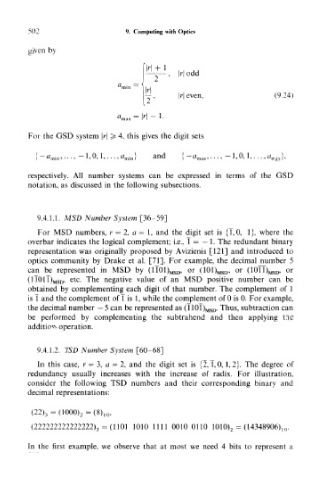Page 517 - Introduction to Information Optics
P. 517
502 9. Computing with Optics
given by
|r|+ i
odd
2 '
! •
a tvt in
r even. (9,24)
i '
n = irl — 1 J
"max I' I '
For the GSD system |r| ^ 4, this gives the digit sets
fl
a
i ~~ min> ' ' - ' — 1, 0 5 1, • • • •> mi n{ an( l '( ~ a min' • • • ' ~ 1, 0, 1, . . . , « nlaji /.
respectively. All number systems can be expressed in terms of the GSD
notation, as discussed in the following subsections.
9.4.1.1. MSD Number System [36-59]
For MSD numbers, r = 2, a — 1, and the digit set is (1,0, 1], where the
overbar indicates the logical complement; i.e., 1 = — 1. The redundant binary
representation was originally proposed by Avizienis [121] and introduced to
optics community by Drake et al. [71]. For example, the decimal number 5
can be represented in MSD by (1101) MSD, or (101) MSD, or (1011) MSD, or
(lTOlT) MSD, etc. The negative value of an MSD positive number can be
obtained by complementing each digit of that number. The complement of 1
is 1 and the complement of 1 is 1, while the complement of 0 is 0. For example,
the decimal number —5 can be represented as (1101) MSD. Thus, subtraction can
be performed by complementing the subtrahend and then applying the
addition operation.
9.4.1.2. TSD Number System [60-68]
In this case, r = 3, a — 2, and the digit set is (2,T,0,1,2). The degree of
redundancy usually increases with the increase of radix. For illustration,
consider the following TSD numbers and their corresponding binary and
decimal representations:
(22) 3 =(1000) 2 =(8) 10 ,
(222222222222222) 3 =(1101 1010 1111 00100110 1010) 2 = (14348906)j 0.
In the first example, we observe that at most we need 4 bits to represent a

